-
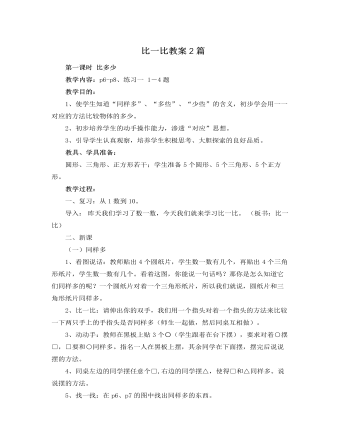
人教版新课标小学数学一年级上册比一比教案2篇
(1)我们比较铅笔的长度,可以说这支铅笔长些、那只铅笔短些;如果我们比较两名同学的身高,应该怎么说?(引导学生说出“高矮”)(板书:高矮)(2)(请两位身高相差较大的同学站起来)谁比较高?谁比较矮?(3)(请两位身高相差不大的同学站起来)能不能一眼看出来,谁比较高,谁比较矮?你有什么方法可以比较出他们两个谁比较高?(小组讨论)(4)小组汇报(5)现在我们来玩一个排队的游戏,四人小组按照从高到矮的顺序排队。(6)练习一 7、8、 4、小结:今天我们学了比较长短、比较高矮的方法。其实除了我们今天所说的方法之外,还有很多种方法,我希望同学们多动动脑筋,想出更多更好的方法。教学反思:在学习《长短、高矮》时,通过老师和学生、学生与学生比高矮,利用手边的铅笔、尺等来比长短,使学生理解长短、高矮是相比较而言的。这些事例是学生身边的,学生看的见、有体验、说的出来、易于理解的。因此,学生学起来容易,而且能够正确的加以运用。
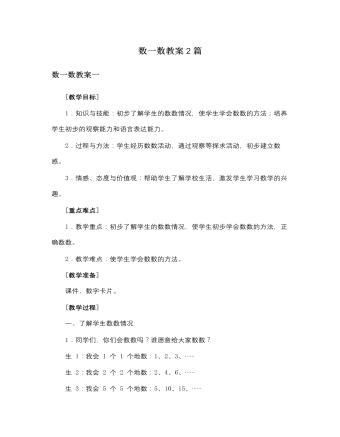
人教版新课标小学数学一年级上册数一数教案2篇
[在学生数的过程中再加强点数的指导,同时有意识的培养学生按顺序数数。另外,在数六朵花、八棵树、九名女生、十名男生的时候,除了 1 个 1 个地数以外,还可以引导学生 2 个 2 个地、3 个 3 个地、4 个 4 个地、5 个 5 个地数数,为后面学习 10 以内各数打基础。] (2)小组进行交流。 再从 1~10 数一数物体的个数。 (3)认一认。 师:你认识这些数吗?边指边读给大家听听。 生:边指 1~10 各数边读一读。 三、巩固练习 1.结合实物,开展数数活动。 (1)按要求数出下面物体的个数。 师:同学们刚才数得真不错!你们愿不愿意数一数自己文具盒中有几支铅笔呀? 生:数出自己文具盒中有几支铅笔并汇报。 师:请同学们数一数你的书包里共有几本书? 生:数出自己书包里共有几本书并汇报…… (2)自由数物体的个数。 师:你还想数哪些物体的个数?和同桌的小伙伴交流一下。
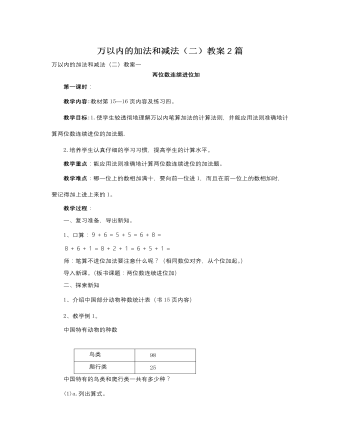
人教版新课标小学数学三年级上册万以内的加法和减法(二)教案2篇
●教学内容:教科书第27页的内容。●教学目标:①通过创设具体的情境,使学生初步学会加法的验算,并通过加法验算方法的交流、让学生体会算法的多样化。②培养学生探索合作交流的意识和能力。③让学生用所学到的验算知识去解决生活中的问题,体会用数学的乐趣。●教具准备:老师准备挂图或课件。●教学过程:创设情境、导入新课。师:同学们,你们与爸爸、妈妈去超市买过东西吗?生:互相说说,再请同学发表意见。师:(挂图1)我们来看挂图,小明和妈妈去超市买东西,从图1中你看到了什么?生1:从图1中我看到了小明妈妈买了一套135元的运动服和一双48元的运动鞋。生2:从图1中我看到小明妈妈给了售货员200元。生3:要知道一套运动服和一双运动鞋一共要多少元?应用加法计算。师:全班动手计算。板书:135+48=183(元)
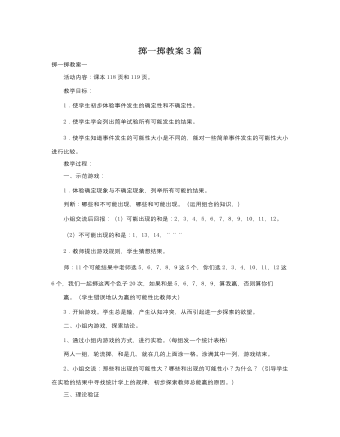
人教版新课标小学数学三年级上册掷一掷教案3篇
3、开始游戏。学生总是输,产生认知冲突,从而引起进一步探索的欲望。(二)小组内游戏,探索结论。通过小组内游戏的方式,进行实验,利用统计的方式呈现实验的结果,初步探索教师总能赢的原因。要引导学生在实验的结果中寻找统计学上的规律。(三)理论验证通过组合的理论来验证实验的结果。可以用不同的方式来进行组合,让学生探讨每个“和”所包含的组合情况的多少与这个“和”出现的次数之间的关系。三、师生共同小结本次活动1、通过本次活动,你有什么新的收获?2、师生总结:本次活动通过猜想、实验、验证等过程,让同学们在问题情境中自主探索,解决问题,既发展了同学们的动手实践能力,又充分调动了同学们的学习兴趣。
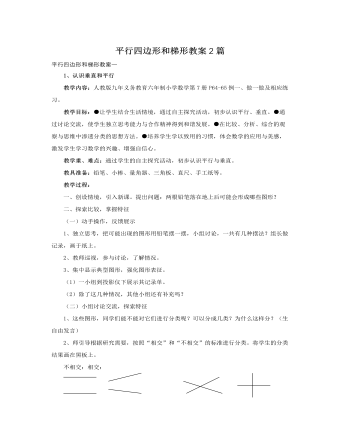
人教版新课标小学数学四年级上册平行四边形和梯形教案2篇
3、师:不相交的两条直线画长一些会怎样?量一量两条相交直线做组成的角分别是多少度?4、由小组同学在原记录单上动手合作操作,并进行讨论、汇报。5、师生共同总结:不相交的两条直线画长一些仍不相交,这两条直线叫平行线,也可以说它们相互平行;相交的两条直线形成的四个角,如果都是90度,就说这两条直线相互垂直,其中一条叫另外一条的垂线,这两条直线的焦点叫做垂足。6、生齐读P65平行和垂直概念,并画下来。7、今天我们就要一起来认识认识平行与垂直。(揭示课题)三、解释应用,巩固新知1、我们天天都在和垂线与平行线打交道:书本面相邻的两边是互相垂直的,相对的两边是互相平行的。2、P64主题图,找一找,图上有哪些平行和垂直的现象?3、做一做1找一找、想一想还有哪些物体的边是互相垂直的,哪些物体的边是互相平行的?
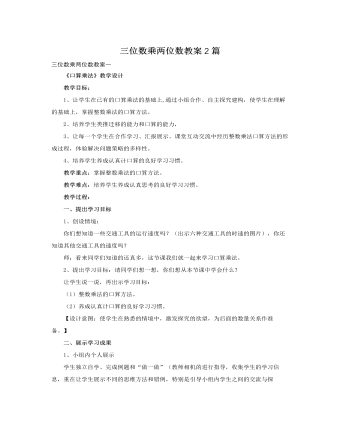
人教版新课标小学数学四年级上册三位数乘两位数教案2篇
教学目标:1、使学生能根据两位数乘两位数的笔算方法,推出并掌握三位数乘两位数的笔算方法。2、进一步培养学生的计算能力。教学过程:一、自主探索笔算方法。1、出示例1:李叔叔从某城市乘火车去北京用了12小时,火车1小时约行145千米。该城市到北京大约有多少千米?2、独立列式:145×12=3、请学生估一估145×12的大致范围。4、尝试算出145×12的结果,并对照估算的情况,算一算估算值与准确值的误差是否合乎实际。5、让学生说一说计算过程。应说以下几点:(1)先算什么;(2)再算什么,积的书写位置怎样;(3)最后算什么。6、师生共同归纳三位数乘两位数笔算一般方法的过程。7、引导学生用不同的方法检验自己运算的结果。二、巩固练习1、课本49页“做一做”学生独立用竖式计算,完成后,可能计算器自行检验。
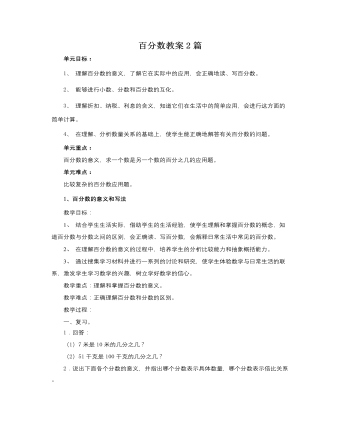
人教版新课标小学数学六年级上册百分数教案2篇
1、完成P78“做一做”第二题:读出下面的分数。2、完成P78“做一做”第一题:直接在书上的横线上写出对应的百分数。3、P79练习十九第4题:读出或写出报栏中的百分数。4、“做一做”第四题:学生根据自己的理解,说说分数和百分数在意义上有何不同。四、布置作业练习十九第1~3题。教学追记:本堂课,我从三个层次入手。第一层:联系生活实际引出百分数;第二层:理解百分数的具体含义;第三层:教学百分数的读写。三个层次,思路清晰,教学层次明显。其中,我把教学重点放在理解百分数的具体含义上,并及时与分数做了比较,教学结构较为严谨。2、百分数和分数、小数的互化教学目标:1、使学生理解并掌握百分数和小数互化的方法,能正确地把分数、小数化成百分数或把百分数化成分数、小数。2、在计算、比较,分析、探索百分数和分数、小数互化的规律的过程中,发展学生的抽象概括能力。3、通过探索百分数和分数、小数互化的规律,激发学生的数学探索意识。
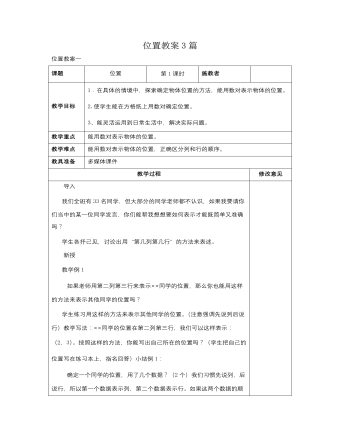
人教版新课标小学数学六年级上册位置教案3篇
【教学过程】一、从实际情景入手,引入新知,使学生学会在具体情景中用数对确定位置1.谈话引入。今天有这么多老师和我们一起上课,同学们欢迎吗?老师们都很想认识你们。咱们先来给他们介绍一下我们班的班长,可以吗?2.合作交流,在已有经验的基础上探究新知。(1)出示要求:以小组为单位,想一想,可以用什么方法表示出班长的位置,把你的方法写或画在纸上。汇报:班长的位置在第4组的第三个,他在从右边数第二组的第三排…哪个小组也用语言描述出了班长的位置?请班长起立,他们的描述准确吗?刚才同学们的描述有什么相同和不同?(都表示的是班长的位置,有的同学说第几组,第几行,第几排……)看来在日常生活中,我们可以用组、排、行、等多种方式,还可以从不同的方位来描述物体的位置。为了我们在确定位置的时候语言达成一致,一般规定:竖排叫列,横排叫行。
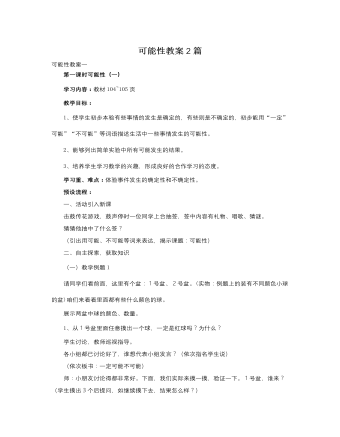
人教版新课标小学数学三年级上册可能性教案2篇
D、师:通过刚才摸球,你认为我们能摸到黄球吗?(能)一定能摸到黄球吗?(不一定)也就是说我们摸到的可能是黄球,也可能是白球。(板书:可能)3、超级竞猜:出示挂图,学生抢答。(课本105页例1)三、拓展应用1、师:在我们生活中同样有很多事情都可以用这些表示可能性的词语来表述。2、完成例2。(1)出示挂图,小组讨论。(2)组织学生汇报交流、评价,你想说哪一幅图的内容就说哪一幅。3、你还能用这些词来说说生活里的事吗?先和同桌交流,然后组织汇报、评价。4、游戏:在三叠卡片中各选一张,按排列顺序组成一句话,说一说这件事发生的可能性。5、作业:在书上完成108页第1、2题。四、总结全课1、师:今天,我们主要学习了什么内容?2、小结:生活里可能性的事情还有很多很多,有些事情一定会发生,有些事情可能会发生,有些事情不可能会发生。希望同学们做生活中的有心人,找一找生活中的可能性。
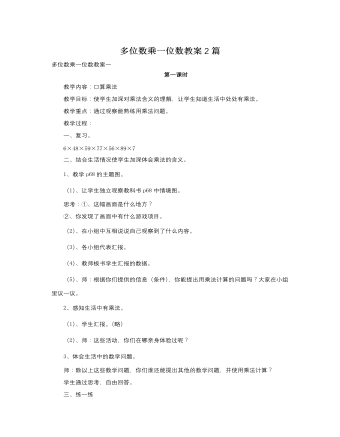
人教版新课标小学数学三年级上册多位数乘一位数教案2篇
教学内容:口算乘法教学目标:使学生加深对乘法含义的理解,让学生知道生活中处处有乘法。教学重点:通过观察能熟练用乘法问题。教学过程:一、复习。6×48×59×77×56×89×7二、结合生活情况使学生加深体会乘法的含义。1、教学p68的主题图。(1)、让学生独立观察教科书p68中情境图。思考:①、这幅画面是什么地方?②、你发现了画面中有什么游戏项目。(2)、在小组中互相说说自己观察到了什么内容。(3)、各小组代表汇报。(4)、教师板书学生汇报的数据。(5)、师:根据你们提供的信息(条件),你能提出用乘法计算的问题吗?大家在小组里议一议。2、感知生活中有乘法。(1)、学生汇报。(略)(2)、师:这些活动,你们在哪亲身体验过呢?3、体会生活中的数学问题。师:除以上这些数学问题,你们谁还能提出其他的数学问题,并使用乘法计算?学生通过思考,自由回答。
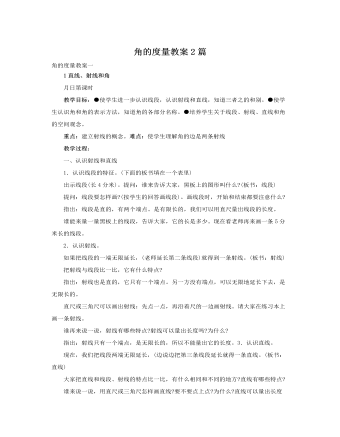
人教版新课标小学数学四年级上册角的度量教案2篇
一、认识射线和直线1.认识线段的特征。(下面的板书填在一个表里)出示线段(长4分米)。提问:谁来告诉大家,黑板上的图形叫什么?(板书:线段)提问:线段要怎样画?(按学生的回答画线段)。画线段时,开始和结束都要注意什么?指出:线段是直的,有两个端点。是有限长的,我们可以用直尺量出线段的长度。谁能来量一量黑板上的线段,告诉大家,它的长是多少。现在看老师再来画一条5分米长的线段。2.认识射线。如果把线段的一端无限延长,(老师延长第二条线段)就得到一条射线。(板书:射线)把射线与线段比一比,它有什么特点?指出:射线也是直的,它只有一个端点。另一方没有端点,可以无限地延长下去,是无限长的。直尺或三角尺可以画出射线:先点一点,再沿着尺的一边画射线。请大家在练习本上画一条射线。
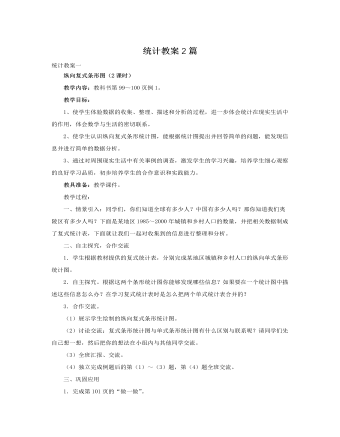
人教版新课标小学数学四年级上册统计教案2篇
教学目标:1、经历简单的收集、整理、描述和分析数据的过程。2、使学生初步了解数据的收集和整理过程,学会整理简单的数据,会看简单的统计表和统计图,会根据统计图表中的数据回答一些简单的问题。3、使学生体验解数据的收集、整理、描述和分析的过程,能发现信息并进行简单的数据分析。4、体会到数学知识与实际生活紧密联系,激发学生的学习兴趣,培养学生细心观察的良好学习品质。教学重点:绘制纵向复式条形统计图。教学难点:根据统计图发现问题、提出问题、解决问题。教具准备:课件。教学过程:一、情境导入:你们知道全球有多少人?中国有多少人吗?那你们知道自己所在的区有多少人吗?下面我们一起对收集到的信息进行整理和分析。二、探究新知:1、根据统计表,分别完成两个单式条形统计图2、根据两个条形统计图你能发现哪些信息?如果要在一个统计图中描述这些信息怎么办?在学习复式统计表时是怎么把两个单式统计表合并的?
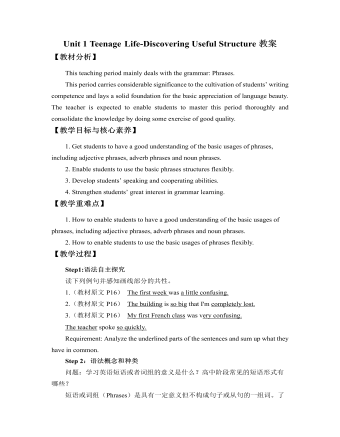
新人教版高中英语必修1Unit 1 Teenage Life-Discovering Useful Structure教案
(形容词短语most beautiful的构成形式为:副词+形容词,该短语在句中作定语修饰名词bird)④A good friend is someone who makes you really happy.好朋友就是能让你真正高兴的人。(形容词短语really happy的构成形式为:副词+形容词,该短语在句中作宾语补足语)[即学即练]画出下例句中的形容词短语并指明构成形式如:It is less cold today than it was yesterday.构成形式: 副词+形容词(1)Our country is becoming more and more beautiful.(2)The road is long enough.(3)The medicine is good for stomach.三、副词短语(Adverb Phrases)副词短语:指以一个副词为中心构成的短语,在句中的功能相当于副词,可以修饰动词、形容词或副词。常见副词短语的构成形式有:(副词)+副词如: much more beautifully①He did his work here yesterday.他昨天在这里工作。(副词短语here yesterday修饰动词did)②Bill did the work very well.比尔做的这份工作很好。副词短语very well修饰动词did③We are all entirely responsible for our action(副词短语all entirely, 修饰形容词短语responsible for)
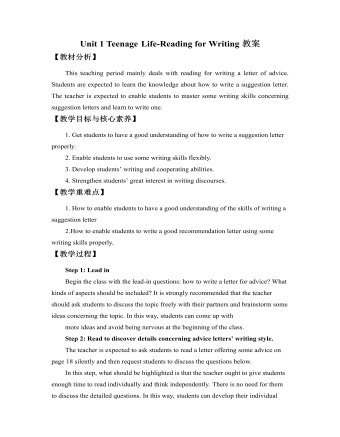
新人教版高中英语必修1Unit 1 Teenage Life-Reading for Writing教案
【教材分析】This teaching period mainly deals with reading for writing a letter of advice. Students are expected to learn the knowledge about how to write a suggestion letter. The teacher is expected to enable students to master some writing skills concerning suggestion letters and learn to write one.【教学目标与核心素养】1. Get students to have a good understanding of how to write a suggestion letter properly.2. Enable students to use some writing skills flexibly.3. Develop students’ writing and cooperating abilities.4. Strengthen students’ great interest in writing discourses.【教学重难点】1. How to enable students to have a good understanding of the skills of writing a suggestion letter2.How to enable students to write a good recommendation letter using some writing skills properly.【教学过程】Step 1: Lead in Begin the class with the lead-in questions: how to write a letter for advice? What kinds of aspects should be included? It is strongly recommended that the teacher should ask students to discuss the topic freely with their partners and brainstorm some ideas concerning the topic. In this way, students can come up with more ideas and avoid being nervous at the beginning of the class.Step 2: Read to discover details concerning advice letters’ writing style.The teacher is expected to ask students to read a letter offering some advice on page 18 silently and then request students to discuss the questions below.

新人教版高中英语必修1Unit 2 Travelling Around-Reading for Writing教案
Is there a clear purpose for the trip? :Does each paragraph have a clear main idea? Does the writer use the present continuous tense for future plans?Does the writer use commas, stops, and question marks correctly? Are all the words spelt correctly?Are all the proper nouns capitalized?Revise your draft according to your partner's comments.Step 5:The summary of how to write a travel plan.旅游计划是一种常见的应用文写作。旅游可分为观光游、文化游、美食游及探险游等不同类型,因此旅游计划也要根据不同的旅游目的进行设计。常规的旅游计划需要明确以下几个方面的问题:Travel planWhen will you leave for? Where is your the destination?How will you get there?What will you do there?How long will you there?Is there a clear purpose for the trip? 为了提升旅行计划的层级,还需注意以下几个方面的问题:1.每段是否有明确清晰的主题;2.用一般现在时代替一般将来时;3.用更高级的形容词词汇。例如:表达“好”时,不要总用“nice”,我们还可以用“smart, clean, excellent, exciting, beautiful, wonderful, clever, famous, grand”等表达更具有指向性的词汇;4.用更高级的动词词汇。比如:我们可以用“seem stand, lie .get stay, remain, look . sound, become . keep, grow”等代替"be";
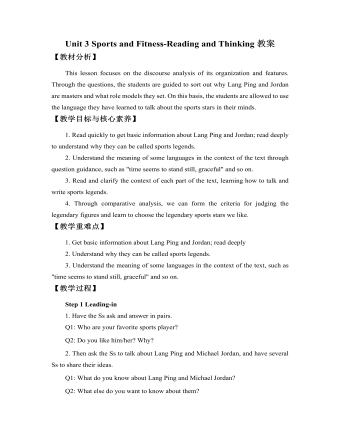
新人教版高中英语必修1Unit 3 Sports and Fitness-Reading and Thinking教案
2. Sort out detailed information about Michael Jordan.(1) Understand the transitional sentence.Q: Which part is about Michael Jordan as a master? Which part is about the example he set?(2) Have the Ss Focus on why Michael Jordan is a master and what good examples Michael Jordan set when they’re reading. And think about these questions as below:Q1: How does the author describe his impressive skills?Q2: How do you understand “time seemed to stand still”?Q3: What does “graceful” mean?Q4. Which sentence do you think best describes his mental strength?Q5. Which words is important in the sentence in describing his mental strength? Why?Q6: How do you understand “unique”?Q7: What can we learn from Michael Jordan?Step 5 Discussing and recommendingRecommend their own living legends of sports.Work in groups to choose your own living legend of sports and give the reasons of your choice. Step 6 HomeworkReview the stories of Lang Ping and Michael Jordan, and try to retell them.

新人教版高中英语必修1Unit 3 Sports and Fitness-Reading for Writing教案
Then have them write a short paragraph to describe and explain their changes. After that, get the Ss to exchange their drafts with their partners and use the checklist to give feedback on their drafts, and finally revise it.Step 5 Summary of how to write a wellness book1.健康书的审题步骤:第一步:明确要求该写作属于经验分享,故要用第一人称来写;时态以一股现在时为主。第二步:确定段落该类文章可以从以下三个方面人手:Para.1首先表明写作的目的Para.2自己的做法及心得体会Para.3表示期望及感谢第三步:提炼要点2.健康书常见句式:1) It is an honor for me to share my favorite sport with you,2) It makes me feel relaxed playing with my friends.3) It makes me rid myself of stress while playing with my friends.4) Moreover, it provides me a valuable chance to communicate with others.5) I we eat too little or too much, or if we choose the wrong food, we may become sick.6) We can do something to change the poor situation.Step 6Homework假如你的老师让你在班级Wellness Bok上分享自己的亲身经历及心得,请根据以下要点写一篇80字左右的文章1. 你喜欢的运动是什么?2. 你最喜欢的原因是什么?3. 你参加锻炼的体会。
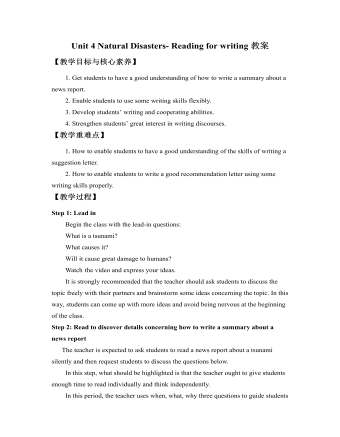
新人教版高中英语必修1Unit 4 Natural Disasters- Reading for writing教案
①标题——标题应当简洁明了。②导语——导语是消息开头的第一段或第一句话,简明扼要地揭示出消息的核心内容。③主体——主体是消息的主要部分,要用充足的事实表现主题,对导语的内容作进一步的展开和阐述。④结束语——通常是对全文内容进行概括性的总结。3. 新闻报道增分句子(1)陈述事实常用的句型:①A terrible storm hit/struck ... , killing ..②It was a cool autumn night when the earthquake happened. A large number of buildings fell down and roads were destroyed, leaving a great many people homeless.地震发生在一个凉爽的秋夜。大量的建筑物倒塌,道路被毁,许多人无家可归。③With the help of the rescue team, people who were the trapped in the flood were saved.在救援队的帮助下,困在洪水中的人们得救了。(2)陈述观点常用的句型:①Clearly/Obviously/In my opinion/It seemed that people were shocked.显然/在我看来/似乎人们震惊了。②The whole city was in ruins after the earthquake.地震后整个城市成了一片废墟。(3)揭示原因常用的句型:Because of/As a result of/Thanks to the help of the army, people who got injured were sent to the hospital immediately.
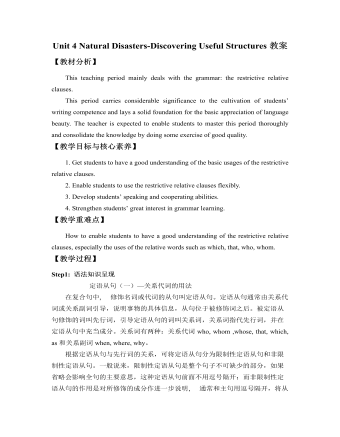
新人教版高中英语必修1Unit 4 Natural Disasters-Discovering Useful Structures教案
【教材分析】This teaching period mainly deals with the grammar: the restrictive relative clauses.This period carries considerable significance to the cultivation of students’ writing competence and lays a solid foundation for the basic appreciation of language beauty. The teacher is expected to enable students to master this period thoroughly and consolidate the knowledge by doing some exercise of good quality.【教学目标与核心素养】1. Get students to have a good understanding of the basic usages of the restrictive relative clauses.2. Enable students to use the restrictive relative clauses flexibly.3. Develop students’ speaking and cooperating abilities.4. Strengthen students’ great interest in grammar learning.【教学重难点】How to enable students to have a good understanding of the restrictive relative clauses, especially the uses of the relative words such as which, that, who, whom.【教学过程】Step1: 语法知识呈现定语从句(一)—关系代词的用法在复合句中, 修饰名词或代词的从句叫定语从句。定语从句通常由关系代词或关系副词引导,说明事物的具体信息,从句位于被修饰词之后。被定语从句修饰的词叫先行词,引导定语从句的词叫关系词,关系词指代先行词,并在定语从句中充当成分。关系词有两种:关系代词who, whom ,whose, that, which, as和关系副词when, where, why。
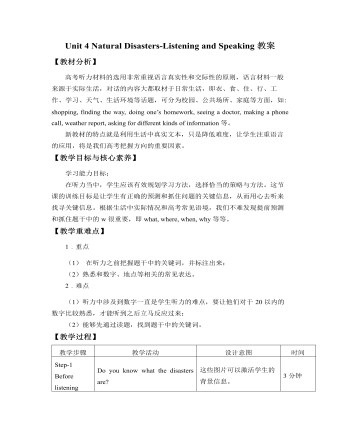
新人教版高中英语必修1Unit 4 Natural Disasters-Listening and Speaking教案
【教材分析】高考听力材料的选用非常重视语言真实性和交际性的原则,语言材料一般来源于实际生活,对话的内容大都取材于日常生活,即衣、食、住、行、工作、学习、天气、生活环境等话题,可分为校园、公共场所、家庭等方面,如: shopping, finding the way, doing one’s homework, seeing a doctor, making a phone call, weather report, asking for different kinds of information等。新教材的特点就是利用生活中真实文本,只是降低难度,让学生注重语言的应用,将是我们高考把握方向的重要因素。【教学目标与核心素养】学习能力目标:在听力当中,学生应该有效规划学习方法,选择恰当的策略与方法。这节课的训练目标是让学生有正确的预测和抓住问题的关键信息,从而用心去听来找寻关键信息。根据生活中实际情况和高考常见语境,我们不难发现提前预测和抓住题干中的w很重要,即what, where, when, why等等。

